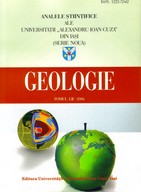
English title
- SERIA
GEOLOGIE (AUI-G) - |

|
| Log in New account |
| Home | Main Page | Guide for Authors | Peer Review | New Articles | Events | Archive | Index | Contact us |

|
Article THE RAMAN STUDY OF AMPHIBOLES
ANDREI IONUŢ APOPEI - “Al. I. Cuza” University of Iaşi, Department of Geology, 20A Carol I Blv., 700505 Iaşi, Romania NICOLAE BUZGAR - “Al. I. Cuza” University of Iaşi, Department of Geology, 20A Carol I Blv., 700505 Iaşi, Romania View abstract as pdf file | View full article as pdf file Abstract: Raman spectroscopy is a simple, powerful and fast method to identify and distinguish between different minerals from the amphibole group of the inosilicate class. We analyzed samples of grunerite, actinolite, nephrite, Cr – actinolite (smaragdite), uralite (var. of actinolite), tremolite, pargasite, glaucophane and riebeckite in order to determine their Raman spectra and their fingerprint. The structure of these amphiboles belongs to the space group C2/m. Also, through this work we intend to show types of linkages between Si and bridging O (Ob) or non-bridging O (Onb), and complex vibrations that occur in all amphibole spectra, corresponding to the symmetric stretching modes (νs) of the Si-Ob-Si bridges or O-Si-O linkages and to the asymmetric stretching modes (νas) of the Si-Ob-Si bridges and O-Si-O linkages. The most distinct Raman peak detected in this Raman study of amphiboles is around 660-675 cm-1, which is assigned to the ν1/νs (symmetric stretching vibrations) of the Si-Ob-Si bridges. Some spectra present two very weak peaks at ~2330 cm-1 and ~2437 cm-1, respectively, due to the substitution of K or Na with H3O+ (K, Na ↔ H3O+) and NH4+ (K, Na ↔ NH4+); these spectral bands were identified at potassium micas. Keywords: amphiboles, Raman spectra, double chain silicates, Si4O11 vibrations, smaragdite, uralite |
copyright © 2024 Department of Geology |